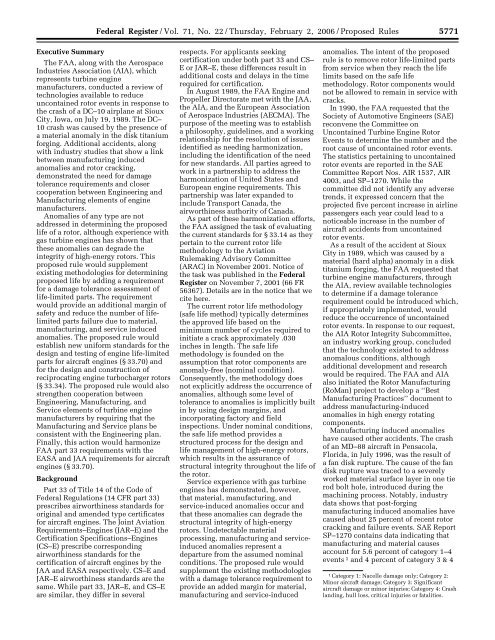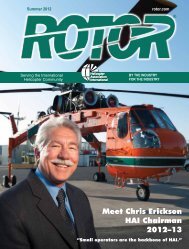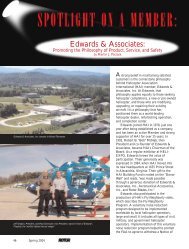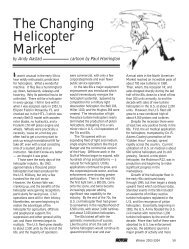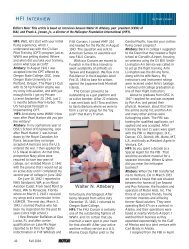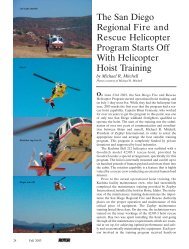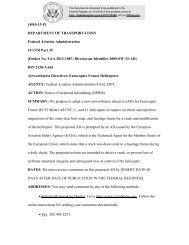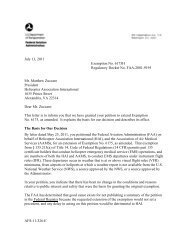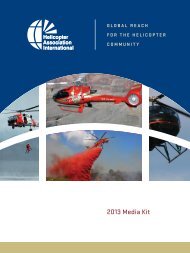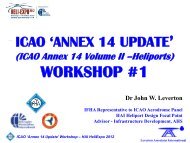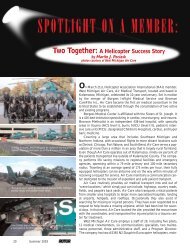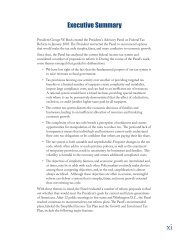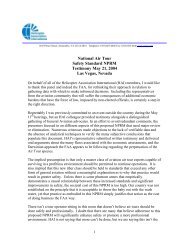Notice of Proposed Rulemaking - Helicopter Association International
Notice of Proposed Rulemaking - Helicopter Association International
Notice of Proposed Rulemaking - Helicopter Association International
You also want an ePaper? Increase the reach of your titles
YUMPU automatically turns print PDFs into web optimized ePapers that Google loves.
Federal Register / Vol. 71, No. 22 / Thursday, February 2, 2006 / <strong>Proposed</strong> Rules<br />
5771<br />
wwhite on PROD1PC65 with PROPOSAL2<br />
Executive Summary<br />
The FAA, along with the Aerospace<br />
Industries <strong>Association</strong> (AIA), which<br />
represents turbine engine<br />
manufacturers, conducted a review <strong>of</strong><br />
technologies available to reduce<br />
uncontained rotor events in response to<br />
the crash <strong>of</strong> a DC–10 airplane at Sioux<br />
City, Iowa, on July 19, 1989. The DC–<br />
10 crash was caused by the presence <strong>of</strong><br />
a material anomaly in the disk titanium<br />
forging. Additional accidents, along<br />
with industry studies that show a link<br />
between manufacturing induced<br />
anomalies and rotor cracking,<br />
demonstrated the need for damage<br />
tolerance requirements and closer<br />
cooperation between Engineering and<br />
Manufacturing elements <strong>of</strong> engine<br />
manufacturers.<br />
Anomalies <strong>of</strong> any type are not<br />
addressed in determining the proposed<br />
life <strong>of</strong> a rotor, although experience with<br />
gas turbine engines has shown that<br />
these anomalies can degrade the<br />
integrity <strong>of</strong> high-energy rotors. This<br />
proposed rule would supplement<br />
existing methodologies for determining<br />
proposed life by adding a requirement<br />
for a damage tolerance assessment <strong>of</strong><br />
life-limited parts. The requirement<br />
would provide an additional margin <strong>of</strong><br />
safety and reduce the number <strong>of</strong> lifelimited<br />
parts failure due to material,<br />
manufacturing, and service induced<br />
anomalies. The proposed rule would<br />
establish new uniform standards for the<br />
design and testing <strong>of</strong> engine life-limited<br />
parts for aircraft engines (§ 33.70) and<br />
for the design and construction <strong>of</strong><br />
reciprocating engine turbocharger rotors<br />
(§ 33.34). The proposed rule would also<br />
strengthen cooperation between<br />
Engineering, Manufacturing, and<br />
Service elements <strong>of</strong> turbine engine<br />
manufacturers by requiring that the<br />
Manufacturing and Service plans be<br />
consistent with the Engineering plan.<br />
Finally, this action would harmonize<br />
FAA part 33 requirements with the<br />
EASA and JAA requirements for aircraft<br />
engines (§ 33.70).<br />
Background<br />
Part 33 <strong>of</strong> Title 14 <strong>of</strong> the Code <strong>of</strong><br />
Federal Regulations (14 CFR part 33)<br />
prescribes airworthiness standards for<br />
original and amended type certificates<br />
for aircraft engines. The Joint Aviation<br />
Requirements–Engines (JAR–E) and the<br />
Certification Specifications–Engines<br />
(CS–E) prescribe corresponding<br />
airworthiness standards for the<br />
certification <strong>of</strong> aircraft engines by the<br />
JAA and EASA respectively. CS–E and<br />
JAR–E airworthiness standards are the<br />
same. While part 33, JAR–E, and CS–E<br />
are similar, they differ in several<br />
respects. For applicants seeking<br />
certification under both part 33 and CS–<br />
E or JAR–E, these differences result in<br />
additional costs and delays in the time<br />
required for certification.<br />
In August 1989, the FAA Engine and<br />
Propeller Directorate met with the JAA,<br />
the AIA, and the European <strong>Association</strong><br />
<strong>of</strong> Aerospace Industries (AECMA). The<br />
purpose <strong>of</strong> the meeting was to establish<br />
a philosophy, guidelines, and a working<br />
relationship for the resolution <strong>of</strong> issues<br />
identified as needing harmonization,<br />
including the identification <strong>of</strong> the need<br />
for new standards. All parties agreed to<br />
work in a partnership to address the<br />
harmonization <strong>of</strong> United States and<br />
European engine requirements. This<br />
partnership was later expanded to<br />
include Transport Canada, the<br />
airworthiness authority <strong>of</strong> Canada.<br />
As part <strong>of</strong> these harmonization efforts,<br />
the FAA assigned the task <strong>of</strong> evaluating<br />
the current standards for § 33.14 as they<br />
pertain to the current rotor life<br />
methodology to the Aviation<br />
<strong>Rulemaking</strong> Advisory Committee<br />
(ARAC) in November 2001. <strong>Notice</strong> <strong>of</strong><br />
the task was published in the Federal<br />
Register on November 7, 2001 (66 FR<br />
56367). Details are in the notice that we<br />
cite here.<br />
The current rotor life methodology<br />
(safe life method) typically determines<br />
the approved life based on the<br />
minimum number <strong>of</strong> cycles required to<br />
initiate a crack approximately .030<br />
inches in length. The safe life<br />
methodology is founded on the<br />
assumption that rotor components are<br />
anomaly-free (nominal condition).<br />
Consequently, the methodology does<br />
not explicitly address the occurrence <strong>of</strong><br />
anomalies, although some level <strong>of</strong><br />
tolerance to anomalies is implicitly built<br />
in by using design margins, and<br />
incorporating factory and field<br />
inspections. Under nominal conditions,<br />
the safe life method provides a<br />
structured process for the design and<br />
life management <strong>of</strong> high-energy rotors,<br />
which results in the assurance <strong>of</strong><br />
structural integrity throughout the life <strong>of</strong><br />
the rotor.<br />
Service experience with gas turbine<br />
engines has demonstrated, however,<br />
that material, manufacturing, and<br />
service-induced anomalies occur and<br />
that these anomalies can degrade the<br />
structural integrity <strong>of</strong> high-energy<br />
rotors. Undetectable material<br />
processing, manufacturing and serviceinduced<br />
anomalies represent a<br />
departure from the assumed nominal<br />
conditions. The proposed rule would<br />
supplement the existing methodologies<br />
with a damage tolerance requirement to<br />
provide an added margin for material,<br />
manufacturing and service-induced<br />
VerDate Aug2005 16:50 Feb 01, 2006 Jkt 208001 PO 00000 Frm 00003 Fmt 4701 Sfmt 4702 E:\FR\FM\02FEP2.SGM 02FEP2<br />
anomalies. The intent <strong>of</strong> the proposed<br />
rule is to remove rotor life-limited parts<br />
from service when they reach the life<br />
limits based on the safe life<br />
methodology. Rotor components would<br />
not be allowed to remain in service with<br />
cracks.<br />
In 1990, the FAA requested that the<br />
Society <strong>of</strong> Automotive Engineers (SAE)<br />
reconvene the Committee on<br />
Uncontained Turbine Engine Rotor<br />
Events to determine the number and the<br />
root cause <strong>of</strong> uncontained rotor events.<br />
The statistics pertaining to uncontained<br />
rotor events are reported in the SAE<br />
Committee Report Nos. AIR 1537, AIR<br />
4003, and SP–1270. While the<br />
committee did not identify any adverse<br />
trends, it expressed concern that the<br />
projected five percent increase in airline<br />
passengers each year could lead to a<br />
noticeable increase in the number <strong>of</strong><br />
aircraft accidents from uncontained<br />
rotor events.<br />
As a result <strong>of</strong> the accident at Sioux<br />
City in 1989, which was caused by a<br />
material (hard alpha) anomaly in a disk<br />
titanium forging, the FAA requested that<br />
turbine engine manufacturers, through<br />
the AIA, review available technologies<br />
to determine if a damage tolerance<br />
requirement could be introduced which,<br />
if appropriately implemented, would<br />
reduce the occurrence <strong>of</strong> uncontained<br />
rotor events. In response to our request,<br />
the AIA Rotor Integrity Subcommittee,<br />
an industry working group, concluded<br />
that the technology existed to address<br />
anomalous conditions, although<br />
additional development and research<br />
would be required. The FAA and AIA<br />
also initiated the Rotor Manufacturing<br />
(RoMan) project to develop a ‘‘Best<br />
Manufacturing Practices’’ document to<br />
address manufacturing-induced<br />
anomalies in high energy rotating<br />
components.<br />
Manufacturing induced anomalies<br />
have caused other accidents. The crash<br />
<strong>of</strong> an MD–88 aircraft in Pensacola,<br />
Florida, in July 1996, was the result <strong>of</strong><br />
a fan disk rupture. The cause <strong>of</strong> the fan<br />
disk rupture was traced to a severely<br />
worked material surface layer in one tie<br />
rod bolt hole, introduced during the<br />
machining process. Notably, industry<br />
data shows that post-forging<br />
manufacturing induced anomalies have<br />
caused about 25 percent <strong>of</strong> recent rotor<br />
cracking and failure events. SAE Report<br />
SP–1270 contains data indicating that<br />
manufacturing and material causes<br />
account for 5.6 percent <strong>of</strong> category 1–4<br />
events 1 and 4 percent <strong>of</strong> category 3 & 4<br />
1 Category 1: Nacelle damage only; Category 2:<br />
Minor aircraft damage; Category 3: Significant<br />
aircraft damage or minor injuries; Category 4: Crash<br />
landing, hull loss, critical injuries or fatalities.


